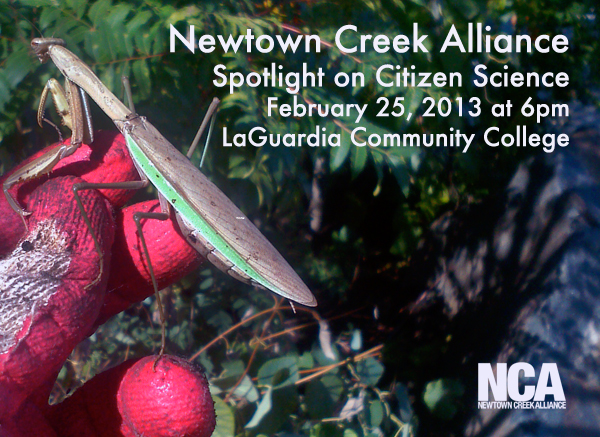NCA’s February meeting will highlight the wide array of local citizen and student scientists exploring all angles of the creek. The meeting will be structured as a showcase, with quick presentations on each topic, and materials for you to peruse in person. Come mingle with your local citizen scientists. Read on for the full line up.
NCA Spotlight on Citizen Science
February 25, 2013 at 6pm
LaGuardia Community College
E Building, Room E-242
Directions
Water Quality – Dr. Sarah Durand and Dr. Holly Porter-Morgan will show student work from LaGCC that “illustrates the reverberating impacts of CSO discharges on several water quality variables”. Also, they will bring one of the colossal plankton tows they use to strain algae et al. out of the creek. Caitlyn Nichols from the Interstate Environmental Commission will be on hand to recount how she spent last summer sampling at the CSO outfalls on Newtown Creek and lived to tell the tale. The North Brooklyn Boat Club did water quality monitoring last year In conjunction with the New York City Water Trails Association, and made a sweet mural to interpret the results. If we are lucky, Leif Percifeld will bring his latest contraption for monitoring water quality or sewer activity.
Air Quality – Researchers and engineers from HabitatMap, New York University, and Carnegie Mellon University have partnered to pilot a community health study examining the relationship between air pollution and human health using wearable sensors and smartphones. The study will use the AirCasting platform to examine how exposure to carbon monoxide and fine particulate matter impact heart rate variability and blood oxygen levels. They are seeking five volunteers to participate in the pilot health study. In order to be eligible, volunteers must live or work within one mile of Newtown Creek and be physically active in the neighborhood. Interested parties or anyone who would like to learn more should contact Michael Heimbinder, Executive Director of HabitatMap and Chair of the Newtown Creek Alliance, at info@habitatmap.org. This work is supported by a “My Air, My Health” Challenge Grant from the US Environmental Protection Agency, National Institute for Environmental Health Sciences, and the US Department of Health and Human Services.
Flora and Fauna – North Brooklyn Boat Club and NCA have been collaborating on documenting the existing critters along Newtown Creek, and we are ready to share some of these observations. We will show results of survey work in the intertidal zone as well as a growing bird list that we developed over the course of the last year. These observations will springboard into designing the edge to support more life and survive a bump from a barge here and there.
Weather Monitoring – In order to better understand how and when the sewers overflow, NCA is collaborating with the S.W.I.M. Coalition, Queens and Brooklyn Public Libraries and Leif Percifeld to install and monitor weather stations throughout the Newtown Creek watershed. The project got started with support from the Hudson River Foundation’s Newtown Creek Fund, and our work has been extended through the Deutsche Bank Americas Foundation. We have added a gauge to our website that indicates if there has been enough rain to potentially cause combined sewer overflows…we are looking for volunteers to help calibrate the system and work with the data!
Bioremediation – Out of NCA’s Bioremediation Workgroup, we have Smiling Hogshead Ranch and The Fortune Society teaming up to offer a bioremediation job force program this year on the Ranch site, two blocks away from both the Newtown Creek and the elevated Long Island Expressway. Soil tests will likely take place later this winter with analysis and planting in spring. The multi-year plan is to train multiple groups in all stages of bioremediation planning and implementation.
Post Sandy Testing – NCA is aggregating a one-stop shop for post-Sandy soil and water sampling that we conducted along with results from private companies, EPA, OSHA and more. This is taking the form of an online redux of all the sampling activity that occurred, and potentially a mapping tool.
